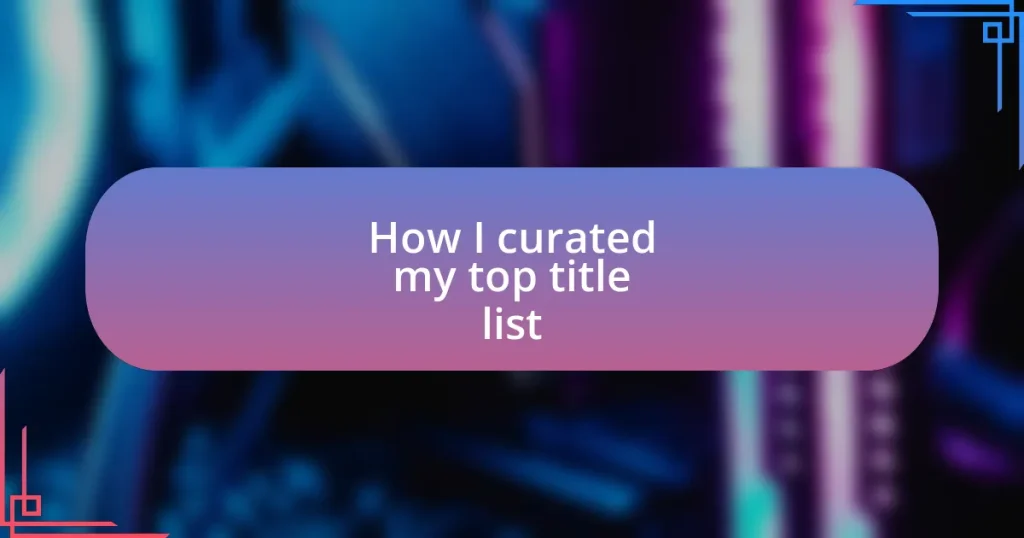Key takeaways:
- The selection of top titles is a personal journey influenced by nostalgia, emotions, and life experiences.
- Researching popular titles involves analyzing reader reviews and identifying universal themes that resonate with audiences.
- Understanding audience preferences requires recognizing the fluidity of tastes based on individual experiences and societal contexts.
- Compiling and refining a list of titles is both an emotional and analytical process, balancing personal connections with broader appeal.
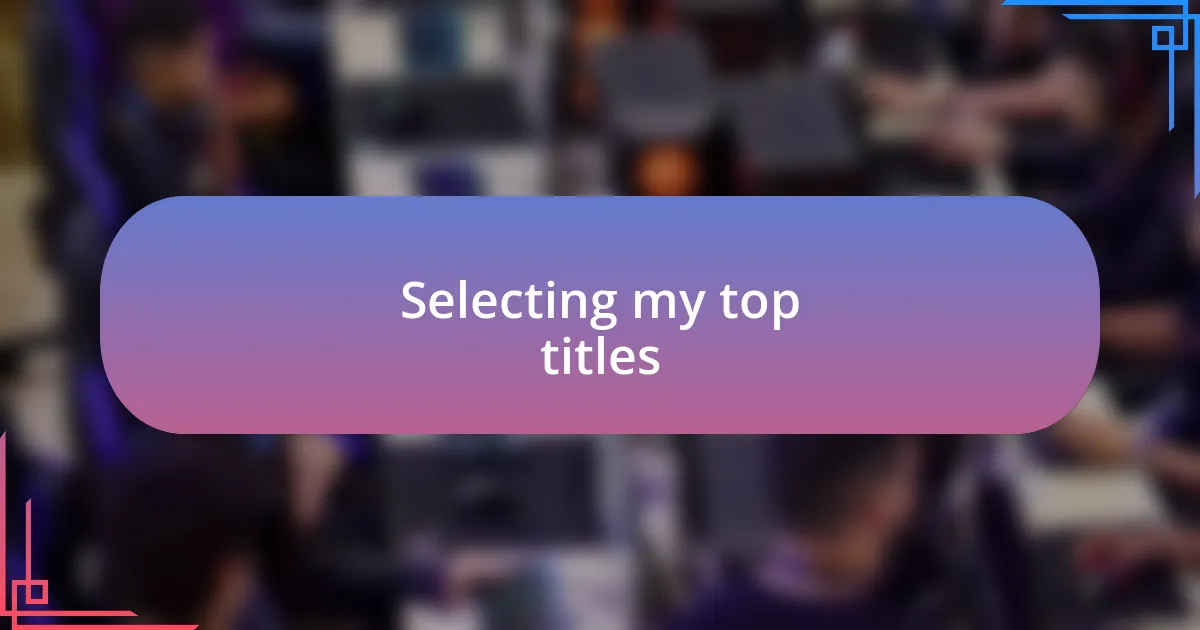
Selecting my top titles
Selecting my top titles was an experience steeped in nostalgia. I remember sitting on my couch, surrounded by stacks of books, reminiscing about the moments each story brought to my life. Did that passage ever make me laugh out loud, or did it linger on my mind for nights? Those emotions shaped my picks.
I often found myself reaching for titles that resonated with my own life journey. For instance, one book helped me navigate a challenging time in my career; its themes of resilience spoke to me profoundly. Have you ever found a book that seemed to whisper the solutions to your struggles? That connection is what truly guided my selection process.
As I narrowed down my choices, I reflected on how each title mirrored different phases of my life. The ones that stood out were not only enjoyable reads but also held lessons and insights I’ve carried with me. It’s fascinating how a book can encapsulate experiences and emotions—what titles have done that for you?
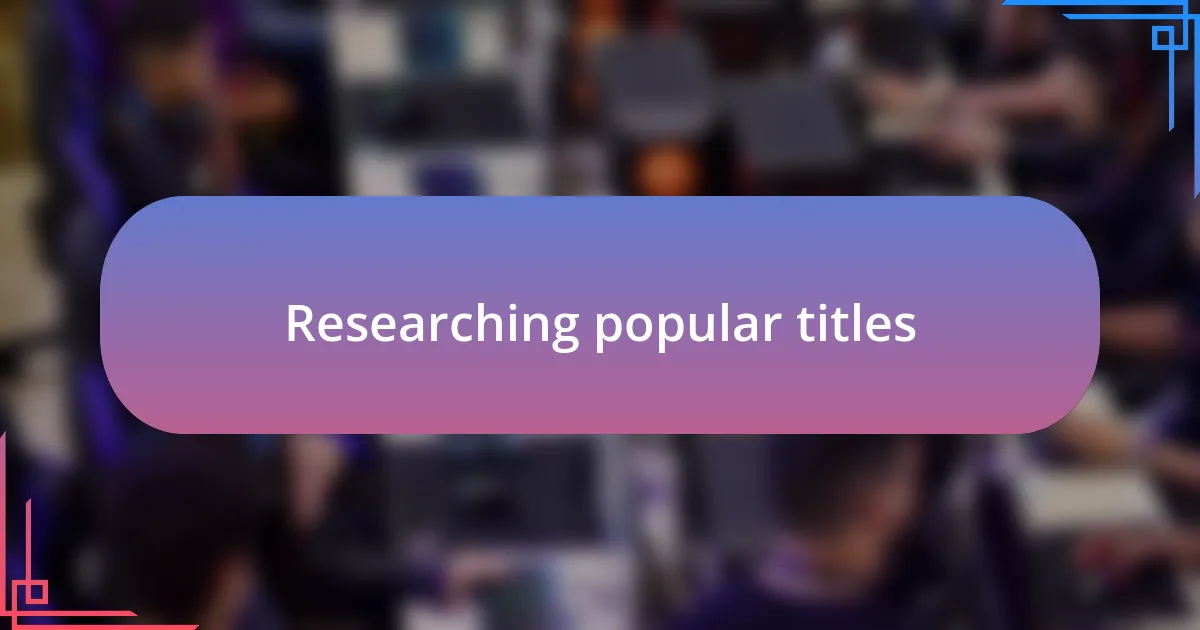
Researching popular titles
Researching popular titles was no small feat. I dove into various platforms like Goodreads and Amazon, soaking up reader reviews and ratings. It was interesting to see how some titles consistently popped up across lists; those must have some magic to them, right? Reading through reviews often sparked my own memories of similar stories, weaving a tapestry of narratives that made me reflect on my own experiences.
As I looked deeper, I compared titles across genres and formats, noticing trends in what readers were drawn to. It struck me that certain themes, like overcoming adversity or finding love, resonated universally, transcending demographics. When I stumbled upon a book that was lauded for its transformational impact, I knew it was worth my time, as I believe every reader deserves a title that speaks to them.
This entire process felt like an adventure, almost like treasure hunting. I kept a running list of titles alongside notes about what caught my attention—stories that elicited strong emotions or offered new perspectives. By cataloging my findings, I could visualize the patterns and shared sentiments that shaped culture and reading communities. It made me wonder: how do titles create their own legacies over time?
| Platform | Focus |
|---|---|
| Goodreads | User-generated reviews and ratings |
| Amazon | Sales rankings and customer feedback |
| Blogger Recommendations | Personal insights and curated lists |
| Social Media | Trending titles and reader discussions |
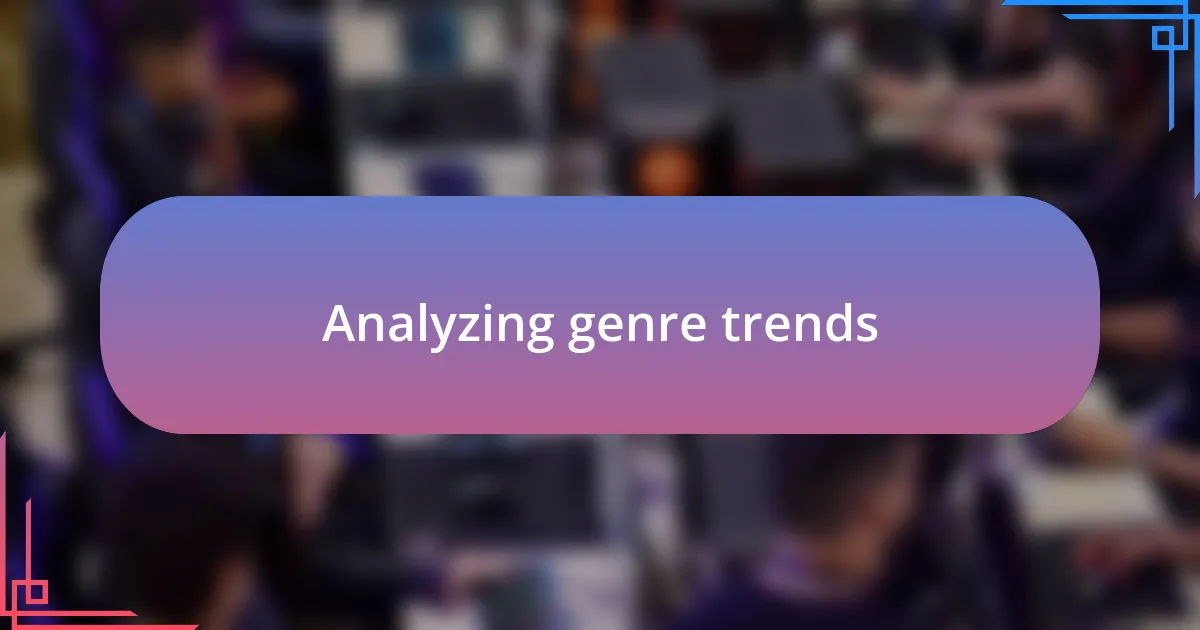
Analyzing genre trends
As I delved into genre trends, the diversity of styles and narratives available today fascinated me. I found that some genres, like psychological thrillers, surged in popularity during times of societal unrest, perhaps reflecting a collective need for escapism or suspense. I remember discussing with friends how historical fiction seemed to make us feel grounded, offering connections to the past amidst rapid changes in our lives.
Here are some key trends I noticed while exploring different genres:
- Romance: Often leads the charts, with subgenres like contemporary and historical gaining traction.
- Fantasy: Popular for its ability to create entire worlds where readers can escape.
- Non-fiction: Gaining momentum, especially in self-help and memoirs that resonate with personal stories of struggle and triumph.
- Graphic Novels: A rising star, appealing to various demographics for their unique blend of visuals and storytelling.
- Thrillers: Attracting readers with their unpredictability, often mirroring real-world anxieties.
In observing these trends, I felt a deeper connection to the narratives we all gravitate towards, reminding me of the universal emotions that literature can evoke.
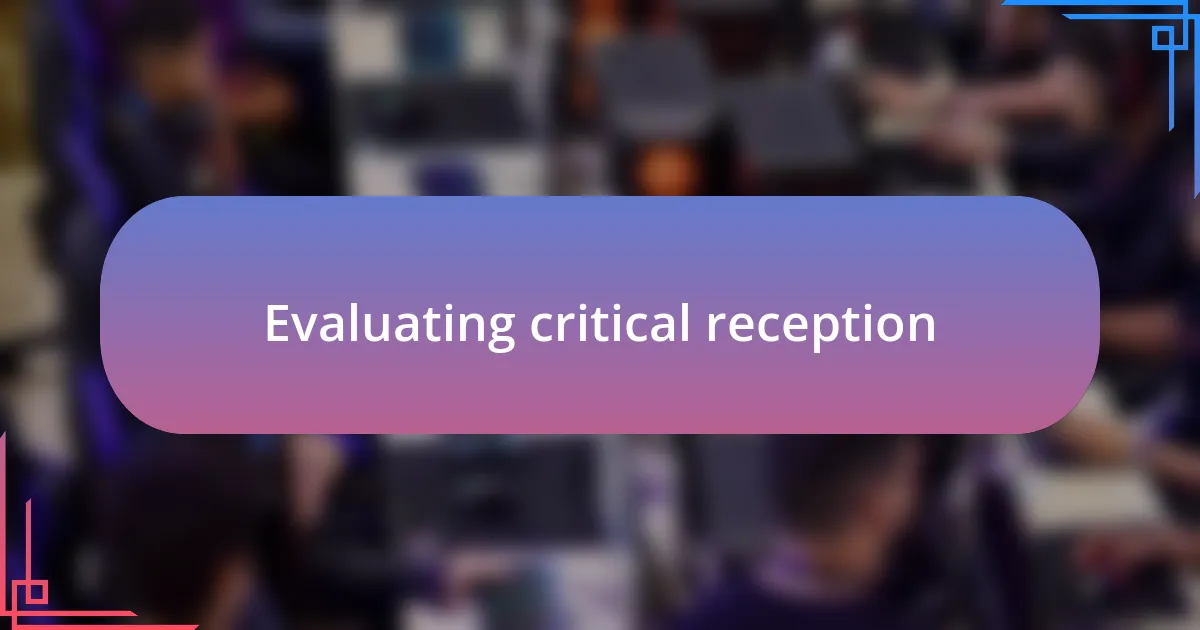
Evaluating critical reception
When evaluating critical reception, I always find it enlightening to browse various reviews and critiques. It’s fascinating how different readers and critics can have such varied reactions to the same title. For instance, I vividly recall reading one review that declared a book a masterpiece while another described it as a tedious read. This contrast often makes me wonder: what is it that shapes our perceptions of a story?
Engaging with aggregate scores, like those from platforms like Goodreads or Metacritic, can provide insight into a title’s overall reception. However, while scores are helpful, I tend to dive deeper into individual reviews. Analyzing the language and sentiments used helps me understand why certain themes resonate—or don’t—with different audiences. It’s like piecing together a puzzle; I try to discern the nuances that may be overlooked in numerical ratings alone.
I also pay attention to the context of the criticism. A novel released during a global crisis? That could skew public perception—perhaps readers are drawn to lighter themes or, conversely, they seek solace in darker narratives. Reflecting on this, I remember how I gravitated toward uplifting stories during particularly tough times, and it made me appreciate the broader impact of a book’s themes on current societal moods.
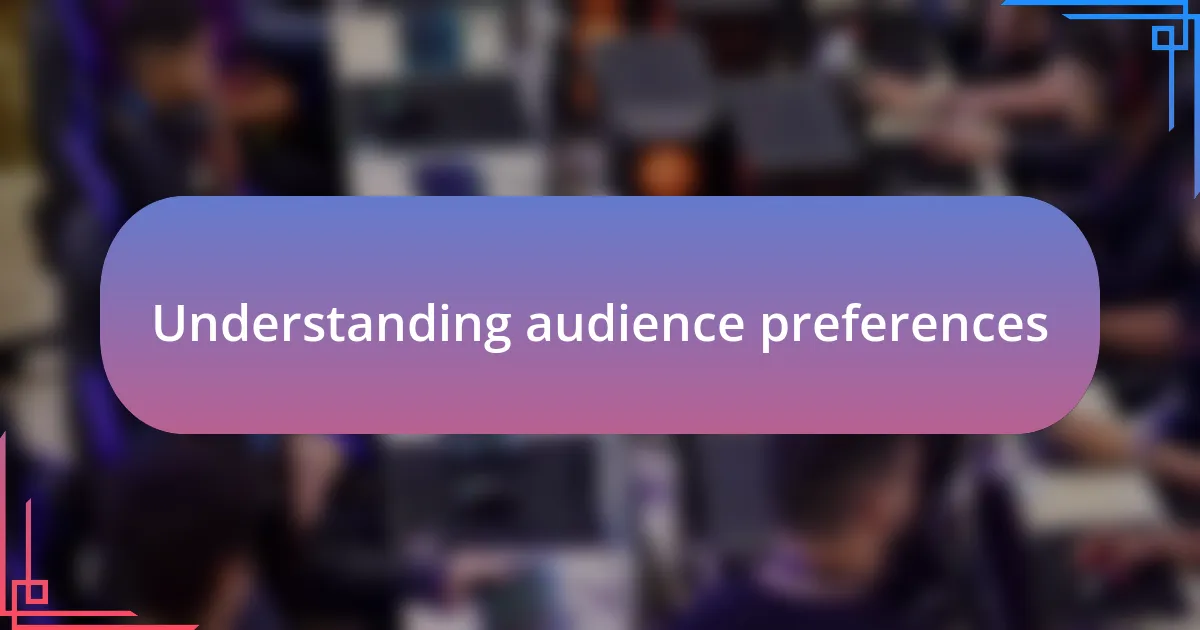
Understanding audience preferences
Understanding audience preferences can be a revealing journey. I’ve discovered that what resonates deeply often hinges on a reader’s personal experiences and backgrounds. For instance, when I recommended a science fiction novel filled with existential themes to a friend who had just experienced a life-changing event, they found it profoundly moving. On the other hand, another friend dismissed it as too abstract, illustrating how individual perspectives can alter the appreciation of the same narrative.
As I reflect on my own reading habits, I notice patterns in my preferences that reveal my identity. There are days when I crave escapism through romance and adventure, while at other times, I’m drawn to hard-hitting non-fiction that challenges my beliefs. This fluctuation in taste has taught me that understanding audience preferences means acknowledging this fluidity—not just what people like, but why. What do you reach for when you need a break from reality? Connecting those dots can help tailor recommendations that resonate on a personal level.
Moreover, feedback from informal discussions with friends about books often uncovers shared or opposing interests that surprise me. For example, one evening at a book club, we debated the merits of a contemporary classic, and the conversations revealed insights into our values and life experiences. This reinforces the idea that preferences aren’t set in stone; they evolve as we navigate different phases in life and societal changes. How often do our choices reflect not just personal tastes but also a broader cultural conversation?
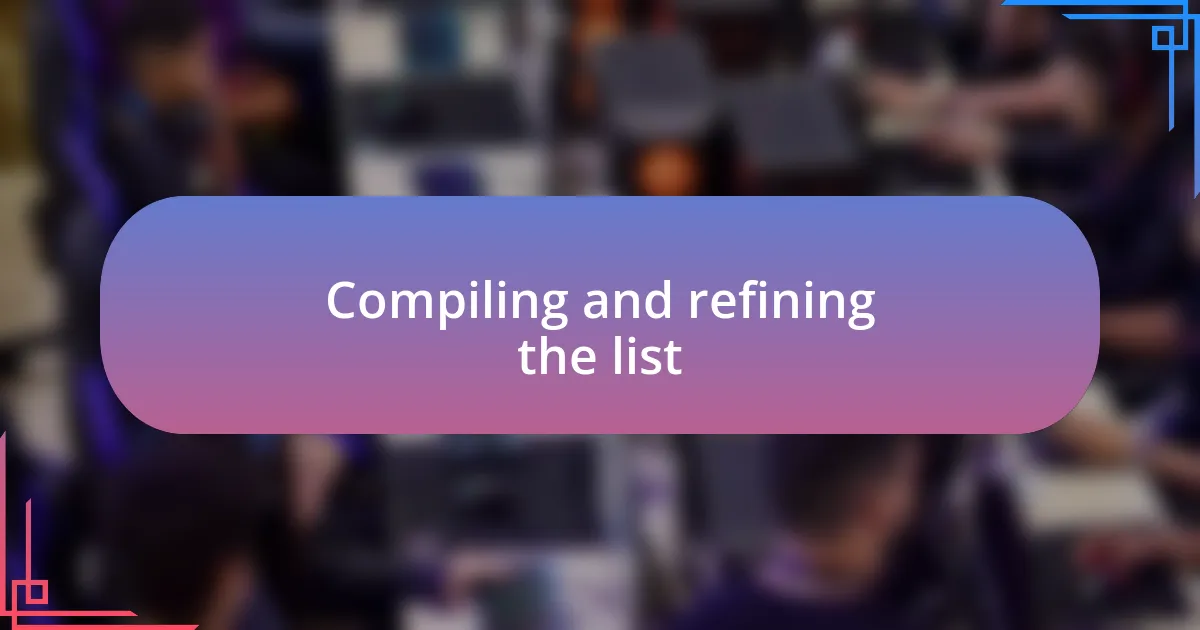
Compiling and refining the list
Compiling my top title list is both an art and a science. In the beginning, I gathered recommendations from various sources: podcasts, book reviews, and even social media buzz. I remember diving into a thread on a reading forum where users passionately discussed their favorite titles. Their shared enthusiasm was infectious, and I jotted down the names of books that sparked lively conversations. Have you ever felt that spark when someone’s excitement about a title just hooks you?
Once I had a preliminary list, the real challenge began: refining it. I revisited each title, thinking about how they resonated with my experiences. For instance, I included a bestselling memoir that had inspired me during a rough patch in my life. But then, I reconsidered—did it truly belong on my definitive list, or was it there due to my emotional attachment? It’s fascinating how our feelings can skew our perception of a book’s broader appeal. How do we balance personal connection with more universal themes when curating?
To narrow it down, I employed a simple criteria: relevance and uniqueness. Each title needed to offer a distinct perspective or voice. I found myself crossing out some crowd-pleasers in favor of hidden gems that I believed deserved more recognition. The process felt almost like pruning a favorite garden—painful yet rewarding. Can you relate to that feeling of letting go to make room for something even more meaningful?
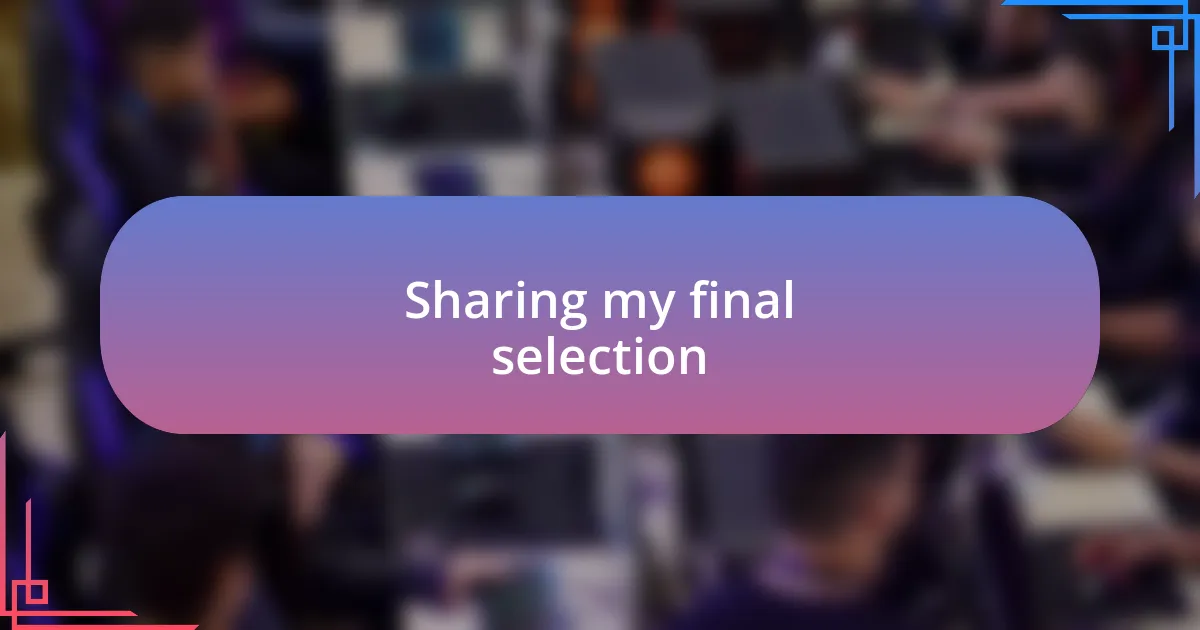
Sharing my final selection
After much deliberation, my final selection emerged, forming a list I feel genuinely excited to share. Each title has a unique story behind it, like the novel that surprisingly transported me to a different era, making me lose track of time. Have you ever read a book that felt like it was speaking directly to your soul? That was my experience with this particular title, and it simply had to make the cut.
As I looked over my list, I couldn’t help but remember the thrill of discovering that elusive book that challenged my thinking. Each selection isn’t just a title; it represents moments of clarity and understanding I’ve had along the way. Wouldn’t it be wonderful if everyone could find that one book that opens their mind in a way they never expected?
What stands out most to me is how diverse my final choices are; they span genres and perspectives. I included a thought-provoking work on philosophy that kept me awake at night, prompting deep reflection. I often wonder, how do we choose titles that not only entertain but also enrich our lives? In the end, I believe my selections reflect my journey toward becoming a more thoughtful reader and individual.











